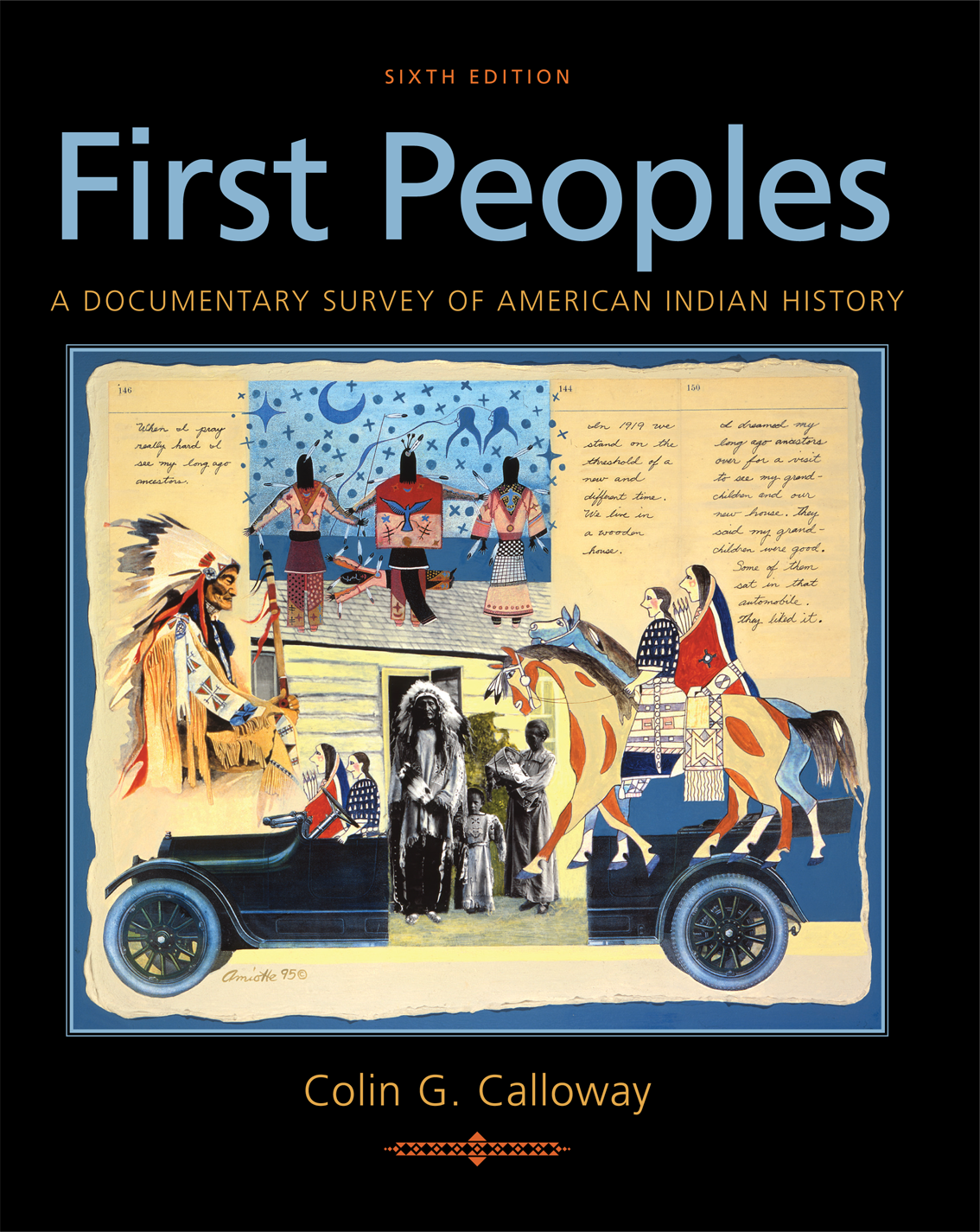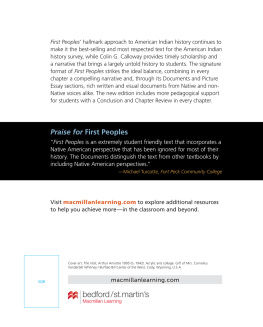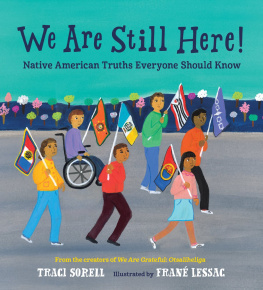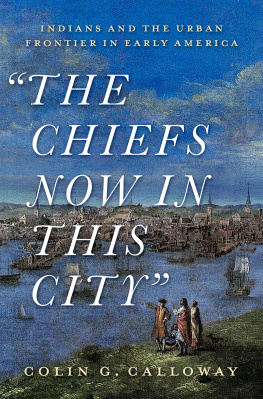Contents
Landmarks
List of Figure

FIRST PEOPLES
FIRST PEOPLES
FIRST PEOPLES

A Documentary Survey of American Indian History
Sixth Edition
- Colin G. Calloway
- DARTMOUTH COLLEGE

For Bedford/St. Martins
Vice President, Editorial, Macmillan Learning Humanities: Edwin Hill
Program Director for History: Michael Rosenberg
Senior Program Manager for History: William J. Lombardo
History Marketing Manager: Melissa Rodriguez
Director of Content Development: Jane Knetzger
Developmental Editor: Mary Posman Starowicz
Content Project Manager: Louis C. Bruno Jr.
Senior Workflow Project Manager: Lisa McDowell
Production Supervisor: Robert Cherry
Senior Media Project Manager: Michelle Camisa
Media Editor: Tess Fletcher
Manager of Publishing Services: Andrea Cava
Project Management: Lumina Datamatics, Inc.
Editorial Services: Lumina Datamatics, Inc.
Composition: Lumina Datamatics, Inc.
Cartography: Mapping Specialists, Ltd.
Text Permissions Manager: Kalina Ingham
Text Permissions Editor: Arthur Johnson
Director of Permissions: Hilary Newman
Senior Photo Editor: Robin Fadool
Photo Researcher: Krystyna Borgen, Lumina Datamatics, Inc.
Director of Design, Content Management: Diana Blume
Text Design: MPS North America LLC
Cover Design: William Boardman
Cover Image: The Visit, Arthur Amiotte 1995 (b. 1942). Acrylic and collage. Gift of Mrs.
Cornelius Vanderbilt Whitney / Buffalo Bill Center of the West, Cody, Wyoming, U.S.A.
Copyright 2019, 2016, 2012, 2008 by Bedford/St. Martins.
All rights reserved. No part of this book may be reproduced, stored in a retrieval system, or transmitted in any form or by any means, electronic, mechanical, photocopying, recording, or otherwise, except as may be permitted by law or expressly permitted in writing by the Publisher.
1 2 3 4 5 6 23 22 21 20 19 18
For information, write: Bedford/St. Martins, 75 Arlington Street, Boston, MA 02116
ISBN 978-1-319-12357-4 (epub)
Acknowledgments
Acknowledgments and copyrights appear on the same page as the text and art selections they cover; these acknowledgments and copyrights constitute an extension of the copyright page.
For Marcia, Graeme, and Megan, as always
PREFACE
MANY PEOPLE for many years considered Native American history to have little or no relevance to the history of the United States. The first peoples to inhabit this continent were routinely ignored, dismissed, or relegated to the sidelines in history texts. If Native people appeared at all in American history books, it was at first contact with the English (Pocahontas) or during the Indian Wars in the West (Sitting Bull and Geronimo). Scholars increasingly recognize that one cannot understand the relatively short history of the United States without acknowledging the very long history, cultural diversity, and enduring presence of Americas indigenous peoples, who shaped this continent and the histories of European colonists and their descendants. In short, American history must include American Indians.
First Peoples provides both an overview of Native American history and an opportunity for students to tackle historical evidence firsthand. The narrative and the documents together tell a more complete and more richly textured story of Indian peoples and their place in U.S. history than is usually presented in history books. Consequently, this sixth edition follows the same approach and pursues the same goals as the previous editions. Each chapter includes a narrative section, followed by primary documents and then a picture essay. By combining historical background with textual and visual evidence, the book provides students with enough context to begin asking questions of the documents and pictures. The structure of the book enables instructors to go beyond giving an outline of events, laws, leaders, and battles and provides them with materials for exploring other issues and examining how Indian history has been written and remembered. The documents give students the opportunity to try to reconstruct the past through the words of people Indians and non-Indians who lived in a different time, saw the world in different ways, and had their own reasons for acting as they did.
FEATURES OF THIS EDITION
The text for the sixth edition has been thoroughly reviewed and, where necessary, revised or updated to take account of developments in Indian country and recent scholarship in Indian history. The new edition restructures several chapters to help students trace central themes and storylines. It also explores the recent shift in U.S. Indian policy resulting from the transition to the Trump administration. The critical intersection of natural resources and Indian sovereignty is revealed in recent court cases and protests surrounding the extension of the Keystone and Dakota Access Pipelines and the reduction of protected lands, such as Bears Ears National Monument, and in the ways indigenous populations are organizing internationally to defend their rights.
The sixth edition includes new, expanded pedagogy to help foster better student understanding. Each chapter begins with a single Focus Question to guide students as they work their way through the narrative. Conclusions and Chapter Reviews have also been added to each chapter, along with lists of key terms, to help students identify important actors, events, and concepts before they move on to the document projects.
Eight new documents are featured, seven of them from a Native perspective: a speech by a Seneca chief defying the French; a recollection of the spread of smallpox to the Blackfeet; a speech by the charismatic pan-Indian leader Tecumseh; an assessment of the Indian Reorganization Act from a member of the Confederated Salish-Kootenai Tribe working for the Office of Indian Affairs; testimony in support of the reauthorizing of the Violence Against Women Act; a U.N. Permanent Forum on Indigenous Issues statement on the Dakota Access Pipeline; a declaration against the Dakota Access Pipeline made by the Standing Rock Sioux Tribal chairman; and the International Indian Treaty Councils Declaration of Continuing Independence. For increased readability, several of the documents retained from the fifth edition have been carefully shortened.
The pairing of documents, introduced in the previous edition to present students with varied historical perspectives, continues in the sixth edition. In explore the intersection of tribal sovereignty, natural resources, and international indigenous rights. Two new documents examine the Standing Rock Sioux Tribes fight to protect their sacred water. The last pairing of the book reveals the long struggle for internationally recognized indigenous rights, tracing efforts from the 1974 Declaration of Continuing Independence by the International Indian Treaty Council to the 2007 U.N. Declaration on the Rights of Indigenous Peoples.









